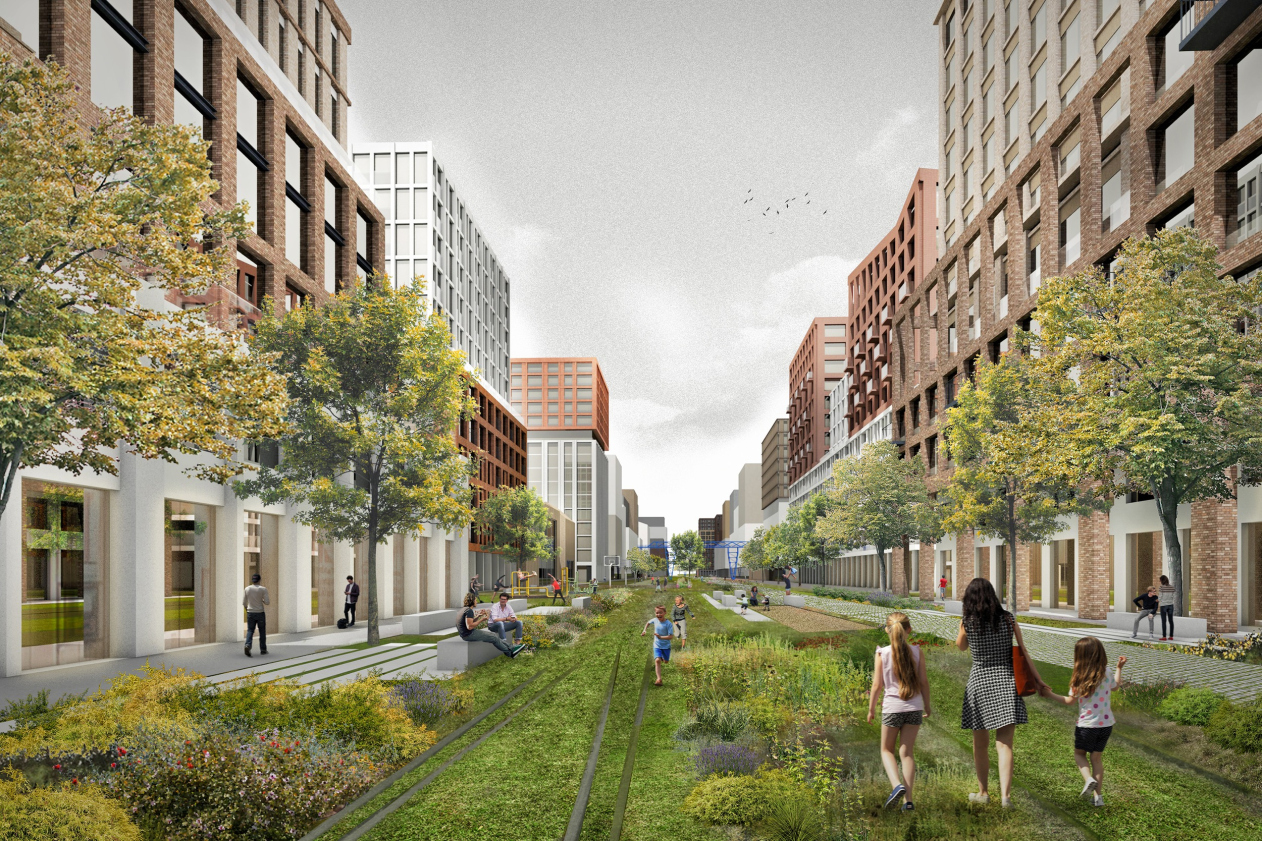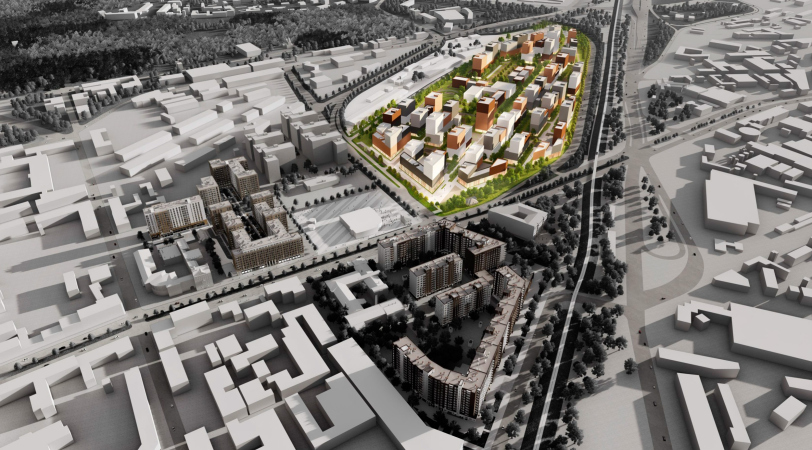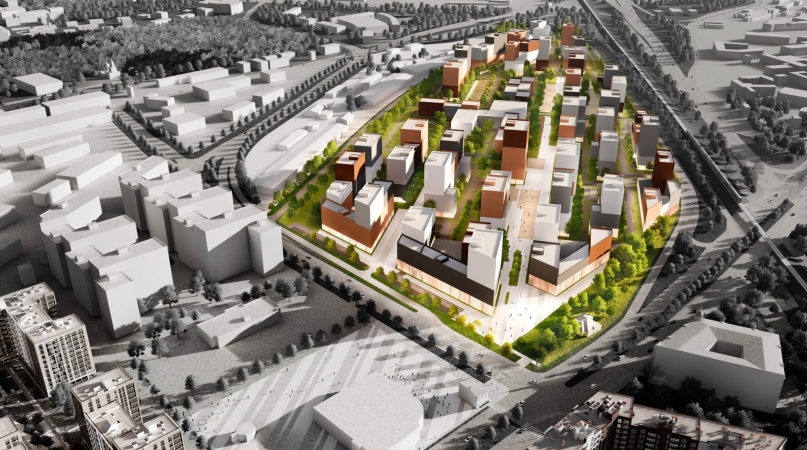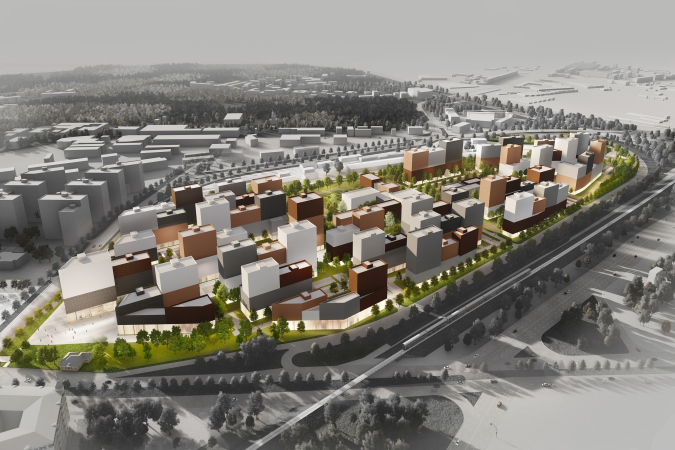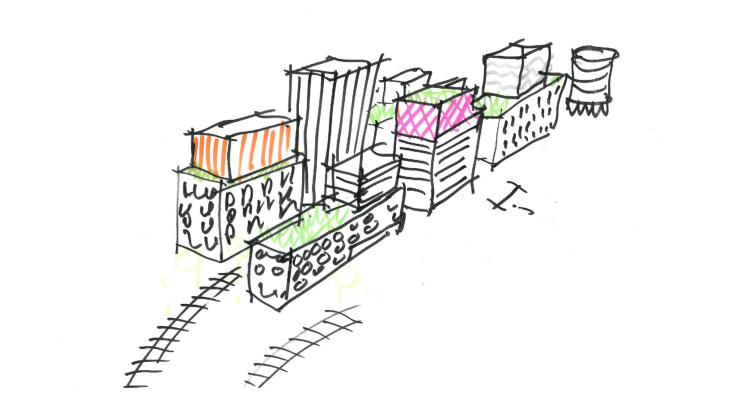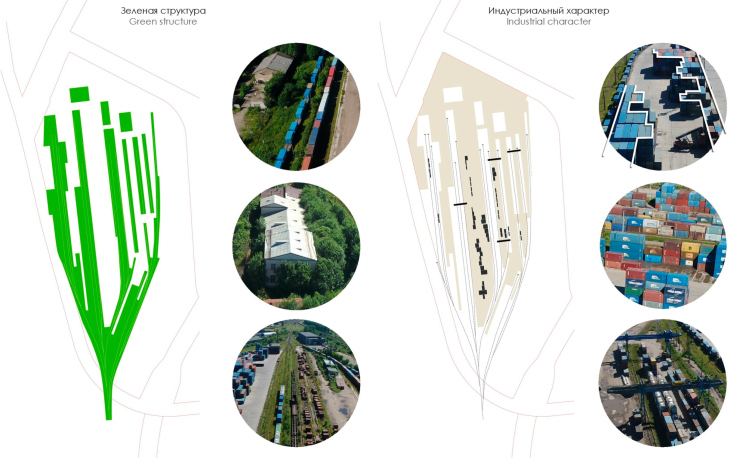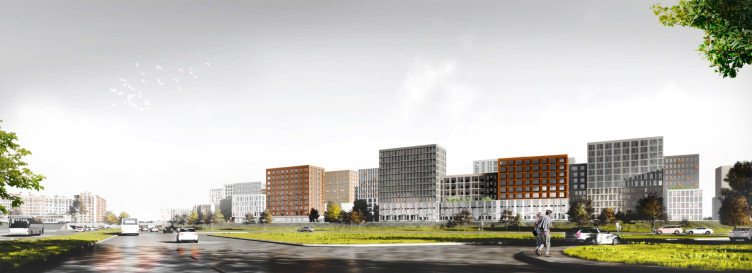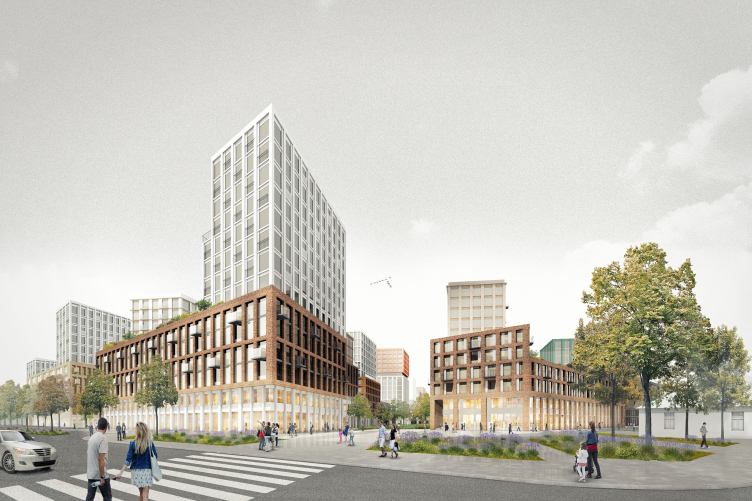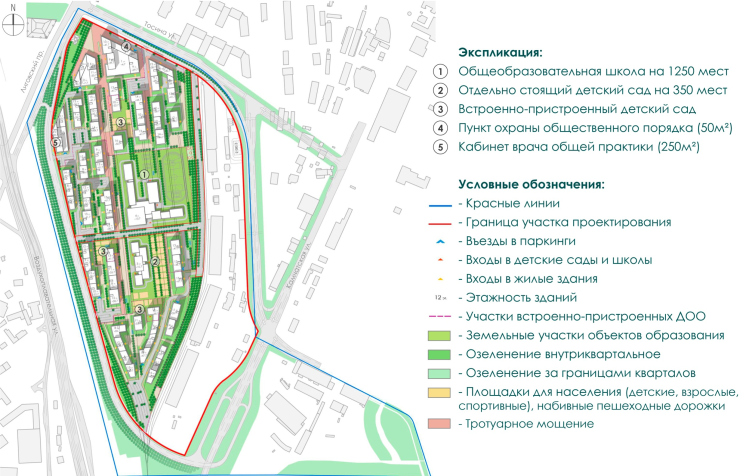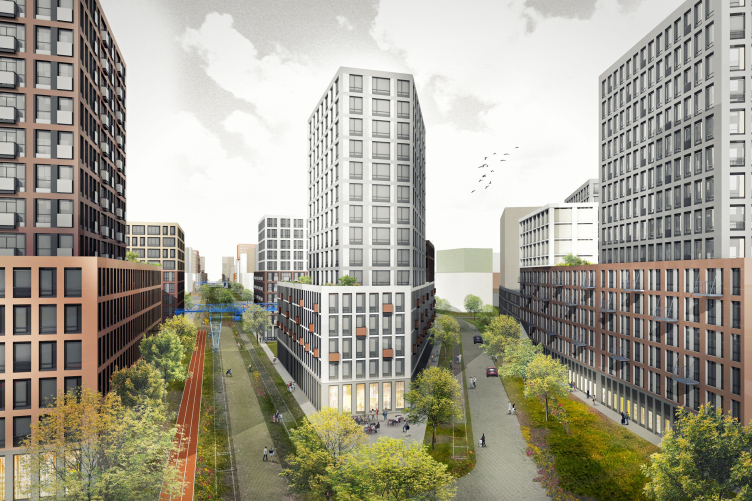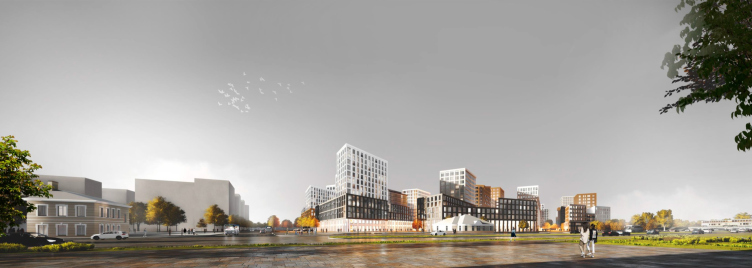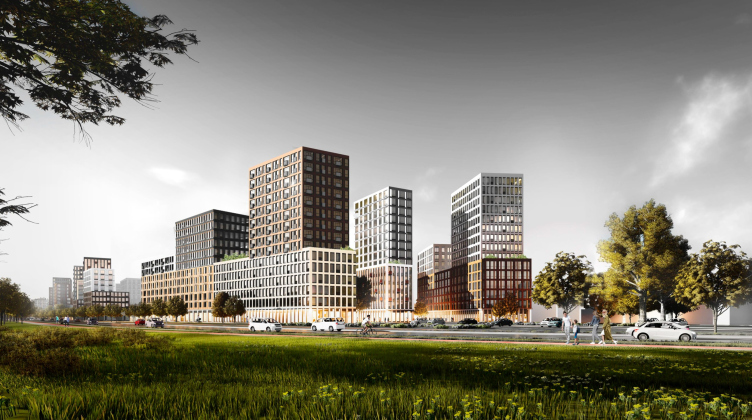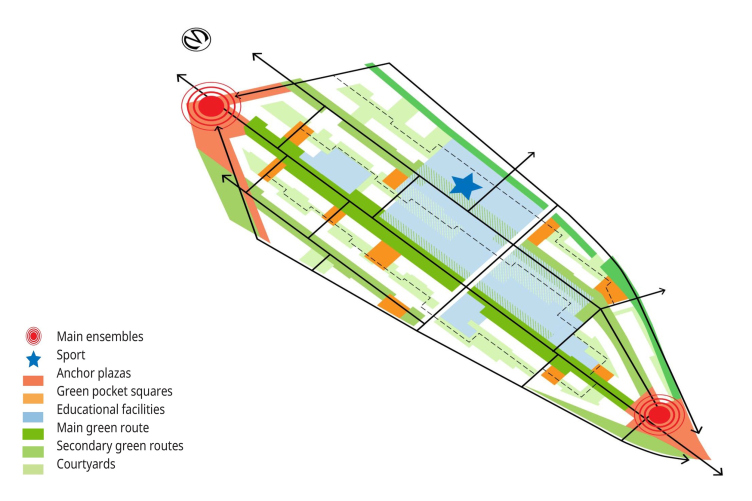*In the headline of the original Russian version of this article, a quote from the song “Railroad Water” by the famous Russian rock singer Boris Grebenshchikov is used, obviously inspired by the Bob Dylan line, which is used in the English version.
The third stage of “Ligovsky City” housing complex is the second joint project by the consortium of the Dutch KCAP + Orange Architects and Saint Petersburg’s A-Len. Their creative alliance formed during the work on the “Golden City” housing complex – back then, in 2015, based on the results of an international competition, the judging panel awarded two first prizes, proposing that the winners unite for collaboration. The construction of a large-scale complex, crowned by impressive golden constructions, is currently underway; some of its parts are almost complete. The collaboration turned out to be successful, and last year the same client, Glorax Development, invited the consortium KCAP & Orange Architects & A-Len to design the third stage of the large housing complex in the “gray belt” of Saint Petersburg. Currently, the project is complete, and on its basis the site plan has been approved.
Golden City, the housing complex standing on wash-up land, i.e. the kind that quite recently did not yet exist – refers to the genius loci of Saint Petersburg in general, saluting with golden grates and spears to the Peter and Paul Fortress and the Admiralty. The core of the “Ligovsky City” housing project also lies in the history of the place, but its narrative is slightly different.
The grand-size land site, about 30 hectares and petal-shaped, is a part of the gray belt; up until 2018 it was occupied by Tovarno-Vitebskaya freight railroad station. The people of A-Len shared that in the early XVIII century there was the Ligovsky Channel dug nearby, which carried water for the fountains of the summer garden and was also a transportation artery. In 1837, south of this location, they laid down the Tsarskoe Selo railroad line, and in 1900 they built a station of the Moscow-Vindavo-Rybinsk railroad line. This land, although demarcated for housing development, was never inhabited – for many years it remained an industrial outskirts with vegetable gardens and an occasional cottage popping up here and there.
Ligovsky City
Copyright: © KCAP Architects & Planners, Orange Architects, A-Len
“Ligovsky City” is probably the first construction project of the gray belt, in which the architects are not trying to erase the past of this locality, turning chaotic underdeveloped land into linear high-rise city blocks, but are looking to keep up the spirit of the past. Specifically, for the construction of the two previous stages of the same block, quarters one and two, the Sausage Factory of 1905 was torn down altogether; the new houses of indifferently neutral architecture do not make the slightest attempt to tell us anything about the past.
The concept of the new, third, stage is based on keeping up the pattern of the railroad track. The rails turn into linear parks and boulevards, and the railway station platforms give way to houses that look like train carriages and freight containers. Since the spatial structure of the territory is kept intact, the architects describe it as “adaptive reuse”.
Ligovsky City
Copyright: © KCAP Architects & Planners, Orange Architects, A-Len
In fairness, it must be noted that a similar idea of “carriage” houses mounted on “rails” was already proposed for this land site in 2016 by Studio 44 when it took part in the competition for renovating the south part of the gray belt. At the city council sitting, where “Ligovsky City” got very positive feedback, Nikita Yavein spoke highly of this idea: “The architects came up with a compositional principle that proceeds from the history of the place, and the context. This creates a true diversity of the forms. It will be bad if the gray belt is developed in such a way as if residential construction has been here forever. Ideologically, I really like this concept.”
Sergey Oreshkin about the project and its consideration by the city council:
Sergey Oreshkin, «A-Len»
The project of “Ligovsky City” was developed by a large group of architects; the team of A-Len, and our long-standing partners – two companies, which are very well-known on the international design market – Rotterdam-based KCAP and Orange Architects. Our company took part in developing the project at all of its stages: from the idea to making the decision about its implementation. More than a year ago, the leaders of our architectural consortium gathered for a workshop, and, as a result of a brainstorming session singled out the advantageous idea of our colleagues from Orange – a concept of linear construction, inspired by the beauty of the railroad tracks, along which we positioned the houses and green corridors with private yards and public spaces. It was decided to preserve, as technical design elements, the objects that broadcast the importance of the pre-revolution “gray belt”. Most of the members of the town planning council appreciated the concept – currently, Saint Petersburg has no such project, executed in the European traditions of renovating industrial territories. The urban green island “Ligovsky City” that we designed once again proves the efficiency of consortiums, particularly with international colleagues.
The land site properties. Ligovsky City
Copyright: © KCAP Architects & Planners, Orange Architects, A-Len
Jeroen Schipper, partner of Orange Architects
We worked together on the Ligovsky City project from the very inception. The architects of A-Len not only supported the development of the project from the standpoint of their knowledge of local legislature, but they also took an active part in developing the concept itself. We relied on the expertise of three offices in order to create a very special project, all the members enriching each other with their approaches and best practices.
When we were in Saint Petersburg still before the beginning of our work, we had the time to take a walk around the future construction site for about two hours, feeling the genius loci – the history of the place is still very tangible here. It was interesting for us to keep up this feeling, even if we fundamentally changed the function of the place – from a freight railroad station, it turns into a bright housing project. Enhancing the character of the place, we are trying to make it worthy of Saint Petersburg.
The historical center of Saint Petersburg is magnificent – it is very well preserved, and, essentially, it is a classic example of a European city. However, the further away you move from the city center, the less humane, logical, and coherent construction becomes. We decided that it was important to trust the identity of this place and create something new for Saint Petersburg: based not so much on the classical as on the industrial heritage of this city.
When we were in Saint Petersburg still before the beginning of our work, we had the time to take a walk around the future construction site for about two hours, feeling the genius loci – the history of the place is still very tangible here. It was interesting for us to keep up this feeling, even if we fundamentally changed the function of the place – from a freight railroad station, it turns into a bright housing project. Enhancing the character of the place, we are trying to make it worthy of Saint Petersburg.
The historical center of Saint Petersburg is magnificent – it is very well preserved, and, essentially, it is a classic example of a European city. However, the further away you move from the city center, the less humane, logical, and coherent construction becomes. We decided that it was important to trust the identity of this place and create something new for Saint Petersburg: based not so much on the classical as on the industrial heritage of this city.
View from the Vozdukhoplavatelnaya Street. Ligovsky City
Copyright: © KCAP Architects & Planners, Orange Architects, A-Len
Masha Pidodnia, associate partner of KCAP
A-Len knows the city; it knows the construction regulations that are particularly hard and complicated in Saint Petersburg, and it knows how to meet them. The complexity of town-planning legislature in Saint Petersburg leaves its mark on the appearance of the modern housing complexes – unfortunately, you need to be very creative if you want to come up with something different. Besides, Sergey Oreshkin is a member of the town planning council, and he knows how to present projects – without him, we would never have prepared the presentation for the Committee for Urban Development and Architecture. All of this helped our team to make the right choices.
Yet another plus: A-Len helped us to tell the story, which was also very important for building up a dialogue with the city and with the client – this was a guarantee that the concept would be implemented without major changes. We always try to study the context, find the strong points, and feel the spirit of the place. However, we need to admit the fact that we look from a different angle, based on our foreign experience and cultural background.
It is generally accepted that Saint Petersburg is primarily about the quarters of the historical center. We also often work with a block type of development, as, for example, on the Vasilievsky Island. In this case, however, we were inspired by the railroad tracks and the freight containers preserved on the site.
Yet another plus: A-Len helped us to tell the story, which was also very important for building up a dialogue with the city and with the client – this was a guarantee that the concept would be implemented without major changes. We always try to study the context, find the strong points, and feel the spirit of the place. However, we need to admit the fact that we look from a different angle, based on our foreign experience and cultural background.
It is generally accepted that Saint Petersburg is primarily about the quarters of the historical center. We also often work with a block type of development, as, for example, on the Vasilievsky Island. In this case, however, we were inspired by the railroad tracks and the freight containers preserved on the site.
Anyway, the former freight platforms are replaced by buildings 6 to 15 floors high. Due to the unusual town planning factor, the configuration of the city blocks is indeed diverse and unique at the same time, the city blocks getting several dimensions at once.
The first dimension is height. The two bottom floors are unified to a certain degree in all of the building and chiefly form the scale of the street. What adds to diversity and coziness here are the annexes no more than for stories high with contrastive decoration and form – for example, the rigidity of perpendicular lines can be diluted by a pitched roof, and the industrial spirit can be somewhat softened by warm wood. The level of the medium (and still comfortable) height is accentuated by broad sections, while the upper level is represented either by light-colored towers or by brightly colored “freight containers”, “stacked” on one another.
View from an in-yard alley. Ligovsky City
Copyright: © KCAP Architects & Planners, Orange Architects, A-Len
Ligovsky City
Copyright: © KCAP Architects & Planners, Orange Architects, A-Len
The other dimension – the “axis” is set by the vector of green corridors and boulevards, whose linear motion is broken but once by a school for 1,250 students. The above-mentioned “cocktail” technique of placing the volumes allowed the architects to avoid a “corridor” effect with blind walls, and achieve that of a gallery: the facades, opening onto the inner streets, are diverse in terms of decoration pattern and materials, and the residents will be able to easily identify their section.
The master plan. Ligovsky City
Copyright: © KCAP Architects & Planners, Orange Architects, A-Len
Ligovsky City
Copyright: © KCAP Architects & Planners, Orange Architects, A-Len
When walking in the linear parks, one can see, in addition to the habitual playgrounds and sports facilities, artifacts, the witnesses of the past – something that in other projects more often than not get rid of. However, it’s all different in the project of the third stage: the architects are planning to integrate into the public spaces and parks what remained of the industrial past of this area: the surviving cranes, pillars, rails, and warehouses. As for the only cultural heritage site that this place has got – the house of the station master built by the project by Stanislav Brzhozovsky, the author of the Vitebsky Railway Terminal – there are plans for restoring it and readjusting for a new function. The public parks are situated along the railroad lines, while the spaces between the buildings conceal cozier inner private yards that are connected to form a single pedestrian route.
Ligovsky City
Copyright: © KCAP Architects & Planners, Orange Architects, A-Len
And, finally, the third position, from which you can review this complex is a broader town planning one. The whole land site is split approximately even by only one automobile road. Next to the north part of the “petal” soon the new metro station Borovaya will appear; the place is going to get a friendly-looking ensemble of a small height with an “inviting” plaza – a new center of attraction in this area. South of the land site, the construction height rises to a climax – an ensemble of three towers that looks like a powerful gate.
View from the intersection of the Ligovsky Avenue and the Tosina Street. Ligovsky City
Copyright: © KCAP Architects & Planners, Orange Architects, A-Len
View from the Vitebsky Avenue. Ligovsky City
Copyright: © KCAP Architects & Planners, Orange Architects, A-Len
Ligovsky City
Copyright: © KCAP Architects & Planners, Orange Architects, A-Len
The whole complex is designed to house 8,600 people; it includes four kindergartners, a large school, underground parking garages and parking lots. The third stage of “Ligovsky City” will be built in four phases, starting from the blocks near Borovaya metro station. In spite of the fact that the concept, which provides for a wide diversity of residential sections, is by default suggestive of organizing competitions, at the city council the client announced their intention to entrust the following design work to the KCAP & Orange Architects & A-Len consortium.

